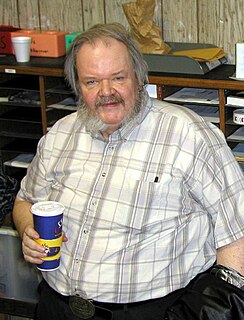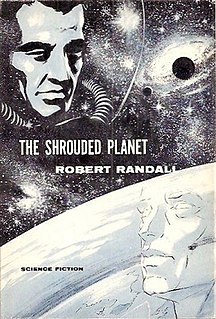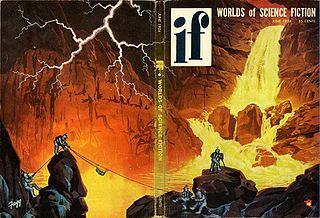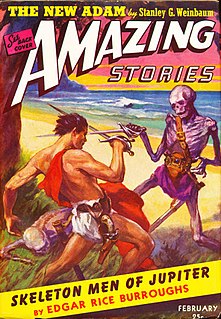
Jack Laurence Chalker was an American science fiction author. Chalker was also a Baltimore City Schools history teacher in Maryland for 12 years, retiring during 1978 to write full-time. He also was a member of the Washington Science Fiction Association and was involved in the founding of the Baltimore Science Fiction Society.

John Holbrook Vance was an American mystery, fantasy, and science fiction writer. Though most of his work has been published under the name Jack Vance, he also wrote several mystery novels under pen names.

Apocalyptic and post-apocalyptic fiction is a subgenre of science fiction, science fantasy, dystopia or horror in which the Earth's civilization is collapsing or has collapsed. The apocalypse event may be climatic, such as runaway climate change; astronomical, such as an impact event; destructive, such as nuclear holocaust or resource depletion; medical, such as a pandemic, whether natural or human-caused; end time, such as the Last Judgment, Second Coming or Ragnarök; or more imaginative, such as a zombie apocalypse, cybernetic revolt, technological singularity, dysgenics or alien invasion.

Science fiction is a film genre that uses speculative, fictional science-based depictions of phenomena that are not fully accepted by mainstream science, such as extraterrestrial lifeforms, spacecraft, robots, cyborgs, interstellar travel or other technologies. Science fiction films have often been used to focus on political or social issues, and to explore philosophical issues like the human condition.

Joe William Haldeman is an American science fiction author. He is best known for his novel The Forever War (1974). That novel and other works, including The Hemingway Hoax (1991) and Forever Peace (1997), have won science fiction awards, including the Hugo Award and Nebula Award. He was awarded the SFWA Grand Master for career achievements. In 2012 he was inducted as a member of the Science Fiction Hall of Fame. Many of Haldeman's works, including his debut novel War Year and his second novel The Forever War, were inspired by his experiences in the Vietnam War. Wounded in combat, he struggled to adjust to civilian life after returning home. From 1983 to 2014, he was a professor teaching writing at the Massachusetts Institute of Technology (MIT).
Jack Carroll "Jay" Haldeman II was an American biologist and science-fiction writer. He was the older brother of SF writer and MIT writing professor Joe Haldeman.

John Stewart Williamson, who wrote as Jack Williamson, was an American science fiction writer, often called the "Dean of Science Fiction". He is also credited with one of the first uses of the term genetic engineering. Early in his career he sometimes used the pseudonyms Will Stewart and Nils O. Sonderlund.

Earthfall (1995) is a science fiction novel by American writer Orson Scott Card. It is the fourth book of the Homecoming Saga, a fictionalization of the first few hundred years recorded in the Book of Mormon.

Nicholas Julian Zapata Sagan is an American novelist and screenwriter. He is the author of the science fiction novels Idlewild, Edenborn, and Everfree, and has also written scripts for episodes of Star Trek: The Next Generation and Star Trek: Voyager. He is the son of astronomer Carl Sagan and artist and writer Linda Salzman.

Planetary romance is a subgenre of science fiction in which the bulk of the action consists of adventures on one or more exotic alien planets, characterized by distinctive physical and cultural backgrounds. Some planetary romances take place against the background of a future culture where travel between worlds by spaceship is commonplace; others, particularly the earliest examples of the genre, do not, and invoke flying carpets, astral projection, or other methods of getting between planets. In either case, it is the planetside adventures which are the focus of the story, not the mode of travel.
Star Trek: Stargazer is a flagship series of Star Trek tie-in novels written by Michael Jan Friedman. The series is set several decades prior to The Next Generation, and follows the exploits of Jean-Luc Picard as captain of the USS Stargazer (NCC-2893).

Space Opera is a novel by the American science fiction author Jack Vance, first published in 1965 by Pyramid Books. It is a stand-alone work, not part of any of Vance's novel sequences. The term "space opera" is typically used in science fiction literature to connote interstellar adventures, clashes of spacefleets and galactic empires. The use here is literal, however, about an opera company touring in outer space.

The Dawning Light is a 1959 science fiction novel published under the name Robert Randall, collaborative pseudonym of American writers Robert Silverberg and Randall Garrett. It depicts the changes, after the events of The Shrouded Planet by the same authors, in the society of the fictional planet Nidor, a world perpetually covered in dense cloud, inhabited by humanoids resembling humans but differing in several respects, notably in being covered from head to foot in short downy fur. The technological level of the society is about that of Renaissance Europe, and has been that way for thousands of years.

The Shrouded Planet is a 1957 science fiction novel published under the name "Robert Randall", actually the collaborative work of American writers Robert Silverberg and Randall Garrett. It consists of three linked stories, each originally published separately in the magazine Astounding Science Fiction. Linking chapters were added for book release. The first book printing, by Gnome Press in New York, was small and did not sell well. This and the sequel novel, The Dawning Light, were reprinted 25 years later.

Fictional depictions of Mercury, the innermost planet of the Solar System, have gone through three distinct phases. Before much was known about the planet, it received scant attention. Later, when it was incorrectly believed that it was tidally locked with the Sun creating a permanent dayside and nightside, stories mainly focused on the conditions of the two sides and the narrow region of permanent twilight between. Since that misconception was dispelled in 1965, the planet has again received less attention from fiction writers, and stories have largely concentrated on the harsh environmental conditions that come from the planet's proximity to the Sun.

Jupiter, the largest planet in the Solar System, has appeared in works of fiction across several centuries. The way the planet has been depicted has evolved as more has become known about its composition; it was initially portrayed as being entirely solid, later as having a high-pressure atmosphere with a solid surface underneath, and finally as being entirely gaseous. It was a popular setting during the pulp era of science fiction. Life on the planet has variously been depicted as identical to humans, larger versions of humans, and non-human. Non-human life on Jupiter has been portrayed as primitive in some works and more advanced than humans in others.

Big Planet is a science fiction novel by American writer Jack Vance. It is the first novel sharing the same setting, an immense, but metal-poor and backward world called Big Planet.
The planetary systems of stars other than the Sun and the Solar System are a staple element in many works of the science fiction genre.

The Collected Stories of Philip K. Dick is a collection of 118 science fiction stories by American writer Philip K. Dick. It was first published by Underwood-Miller in 1987 as a five volume set. See Philip K. Dick bibliography for information about the mass market reprints.

Marune: Alastor 933 (1975) is a science fiction novel by Jack Vance, the second of three books set in the Alastor Cluster, ‘a whorl of thirty thousand stars in an irregular volume twenty to thirty light-years in diameter’. Three thousand of the star systems are inhabited by five trillion humans, ruled by the mostly hands-off, laissez-faire Connatic, who occasionally, in the manner of Harun al-Rashid of The Thousand and One Nights, goes among his people in disguise. The novel was preceded by Trullion: Alastor 2262 (1973) and followed by Wyst: Alastor 1716 (1978).
















